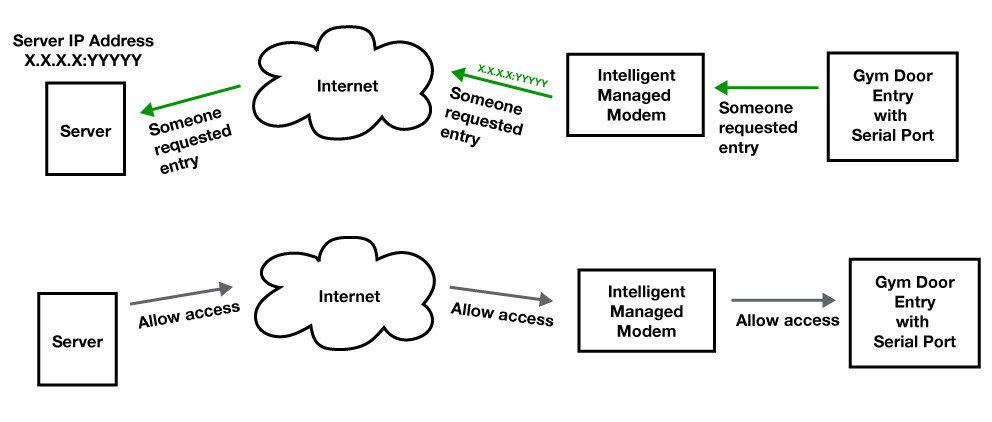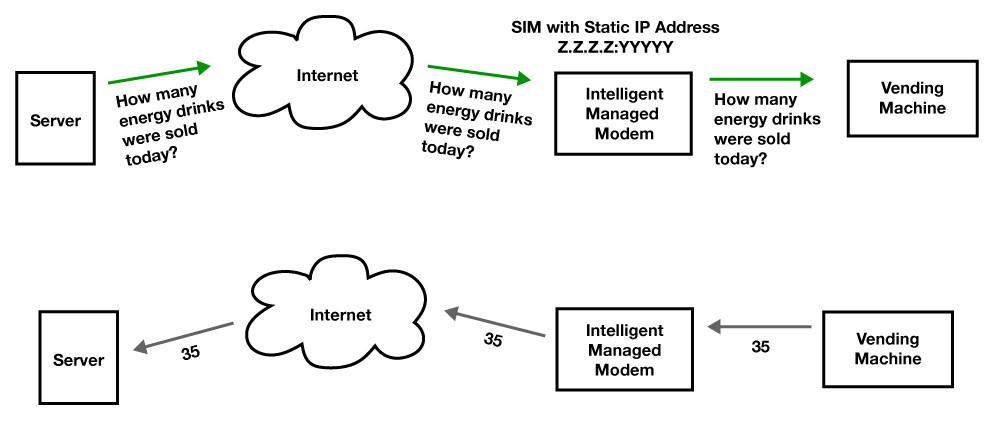If you are anything like me, you will hardly ever go to the gym… and for those of you wondering what a gym is, it is a public place you can go to exercise, get fit, or just admire all the really good looking people!
Now you are wondering, what does this have to do with the Siretta’s intelligent managed modems? Well, the gym makes a perfect example for what intelligent managed modems are deployed for, and how they are being used around you in a number of applications that you probably aren’t even aware of.
Firstly, let me introduce you to the intelligent bit itself…
A piece of software is run on our Siretta modems and connects to your end equipment via RS232, available in 2G and 3G technologies.
The software combined with one of our 2G/3G modems allows communication between a server and piece of equipment by using the 2G/3G network, seamlessly. The software automatically manages the serial link between the intelligent managed modem and remote equipment and will reconnect if there are any network dropouts, maintaining a 24/7 connectivity which is what you need when monitoring equipment in the field… right?
The intelligent managed modem has 2 methods of sending and receiving data.
- Client Mode – This allows the intelligent managed modem to communicate back and forth with a server by using the server’s IP address. In this instance, the intelligent managed modem will always initiate the communication between the 2.
- Server Mode – This allows the server to communicate back and forth with the intelligent managed modem, by using intelligent managed modem’s fixed IP address. In this instance, the server will always initiate the communication between the 2.
In both cases the communication (data transfer) is bi-directional.
So back to my gym analogy…
This will hopefully explain to you exactly how the intelligent managed modem, Client Mode and Server Mode are used.
I’ve finished work, I’m now at the leisure centre ready to check into the gym. I take out my gym card and swipe it on the door entry system, about 3 seconds later the door then opens and lets me into the gym. Now, that door entry system was connected to the intelligent managed modem. When I swiped my gym card, the intelligent managed modem sent a communication to the server letting it know someone had requested entry into the gym. The server then processes this information, identifies if I am allowed into the gym, and then sends a message back to the intelligent managed modem either granting or denying me access. This would be Client Mode because the door entry system – in this case connected to the intelligent managed modem – is initiating the communication with the server by sending it a message saying “Someone requested entry” and to my relief (I don’t know if relief is true, but we will go with it), the server said “Allow access”.
Figure 1. Client mode diagram, me being let into the gym
Now I’m going to go on the treadmill (I don’t normally do this, I normally mill around the gym pretending I’m doing something but for the sake of this example I was using the treadmill). After about 30 minutes on the treadmill I feel like I need an energy drink. My gym has a vending machine, so I quickly pop over to the vending machine and get a nice sugar filled drink to re-energize myself.
I finish my drink then decide to lift some weights for a bit. I start with 20kg hammer curls (which is hilarious because if you ever saw me, you’d realise I probably couldn’t hammer curl 5kg, let alone 20kg… but like I said, for the sake of this example). After another 25 minutes I’m finished at the gym and leave.
Now you’re thinking, “She hasn’t explained Server Mode!!!!!!” but low and behold, here we go. So let’s go back about 30 minutes… remember when I used the vending machine? Well that vending machine also had an intelligent managed modem connected to it. However, this intelligent managed modem was set up in Server Mode. At midnight, once the gym has been closed and the cleaners have been, the communication begins. However, this time, the server sends a message to the intelligent managed modem, “How many energy drinks were sold today” to which the intelligent managed modem/vending machine responds “35”. The server can then do what it needs with this information, in this instance it will send an alert to the maintenance team notifying that the vending machine needs refilling with 35 energy drinks.
Figure 2. Server mode diagram, server requesting number of energy drinks sold
And that is it… As simple as that!!
Client mode starts the conversation with the server. Server mode starts the conversation with the intelligent managed modem and end equipment it is connected to. If only everything was that easy?
Hopefully you now have a much clearer understanding of what the intelligent managed modem is and how it can be used in almost any application to send and receive data… and that is the end of “intelligent managed 2G and 3G modems – FOR DUMMIES”.
Now, I am off to find out if this intelligent managed modem can cancel my gym membership.



